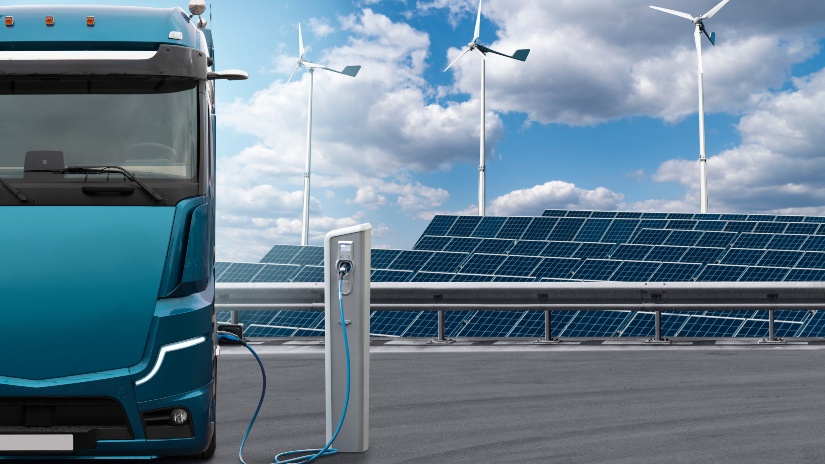By Anthony Allard, Executive Vice President and Head of Hitachi Energy North America
While every sector has a role to play in enacting changes that support a sustainable future, the role of the transportation sector is particularly significant. In fact, with 27% of greenhouse gas emissions1 coming from transportation sources, the industry is poised to serve as a catalyst for transitioning the world to a carbon-neutral future. Electrification is the common denominator, and transportation leaders are depending on bold initiatives to transform our electrical infrastructure in anticipation of a massive increase in demand.
At Hitachi, we know from firsthand experience that strategic partnerships are instrumental in accelerating the pace of transformation on such a scale. Through our collaboration with Penske Corporation, we showcase how like-minded partners can develop solutions that make a meaningful impact on both operational excellence and service to society.

By collaborating for more than a decade, Hitachi and Penske have made groundbreaking advances in sustainable processes and technologies such as proactive diagnostics, which uses machine learning and artificial intelligence allowing to predict fleet repair and maintenance requirements, and provide the services for improved maintenance accuracy. Those collaborations set the stage for further progress toward sustainability — a high priority for Penske, which operates among the largest and most diverse fleet of electric trucks in the United States as well as one of the first heavy-duty truck charging networks.
By partnering with Hitachi and utilizing its Grid eMotion Fleet™ solution, the company has built a prototype network of charging stations in Southern California as part of its initial efforts to transition to a fully electrified fleet. The next step is to scale this infrastructure across the entire organization and all business lines at Penske.
“We built a system that worked, and although that early deployment might be the largest fleet of its kind out there, it's still not near the size of our overall fleet of more than 360,000 vehicles,” says Jonathan Gibson, Penske’s executive vice president of marketing and business development. “How do we get to that scale? That's really the next chapter that we've been working on with Hitachi as we start to design, build, implement, and deploy systems to ensure that we can keep up with the pace that our customers demand when we roll out more of these battery-operated electric vehicles.”

Recognizing electrification as a sustainable mobility solution is only half the battle. In working with Penske to scale out its charging system, Hitachi is employing a technology that it developed specifically to address commercial and public transportation electrification.
Like Penske, electric bus and truck fleet operators need to scale. Currently, demand completely overshadows supply — and it will only continue to grow. Satisfying that demand will require effective deployment of a charging infrastructure that can serve a high volume of vehicles to allow these trucks and buses to get into service quickly and expand as needed as fleets grow.
Hitachi Energy’s innovative grid-to-plug charging system, Grid-eMotion Fleet™, moves electric vehicles (EVs) from niche to mainstream. Based on direct current (DC) system technology, the system is designed to fit into space-constrained parking areas such as bus terminals and truck depots and connect all necessary charging points seamlessly to the grid.
Grid-eMotion Fleet™ addresses one significant scaling obstacle for Penske: the ability to charge many vehicles at once. “When you've got a single post that syncs up to a charging cabinet, you can charge only that vehicle,” explains Bill Combs, vice president of sustainability at Penske. “Distributed charging, like we're talking about with Grid-eMotion Fleet™, is designed to conquer that challenge. So instead of having a one-to-one ratio, we have a whole system installed on the premises, and we can hook up as many different charges as we want to that system.”

Expanding the charging network is a key step forward, but there are additional factors that require consideration.
Through Hitachi’s work in mobility electrification, we’ve learned that electrification is about more than introducing electric vehicles into the fleet and building a charging infrastructure. The transition requires extensive planning and a holistic approach that includes building the right relationships with utilities, which is an area outside the scope of most fleet companies like Penske. Large-scale EV charging can place significant demands on local distribution grids, which can require upgrades to grid infrastructure. Hitachi has the experience and expertise to help address these requirements.
Moreover, electrification introduces unfamiliar variables into the fleet maintenance equation.
“It's about the maintenance, but it's also about the driver behavior, the source of electricity, the grid impact, the cost of electricity, when you charge, how often you charge, routes and optimizing the routes,” says Hicham Abdessamad, Chairman and CEO of Hitachi America, Ltd. “It may seem overwhelming – but the reality is that there is sophisticated software with predictive models that allow you to optimize your entire value chain. And there are partners you can work with that can help you transition.”
Learn more about how Hitachi is collaborating with leading companies to turn sustainable transportation into a reality.

Executive Vice President and Head of Hitachi Energy North America
Anthony Allard is Executive Vice President, Managing Director, United States and Head of Hitachi Energy’s business in North America. Allard was most recently CEO of BECIS, a leading energy-as-a-service-solution provider in Singapore. He held several executive-level positions in the power sector, including General Manager and Board Member for GE Prolec Transformers. He was General Manager for the GE-XD High Voltage Products partnership and held strategy and operations management roles for Alstom Grid in North America and the Americas.
Allard holds an MBA from Yale University and a Masters in Electrical Engineering and Telecommunications from the Institut Polytechnique de Grenoble, France.